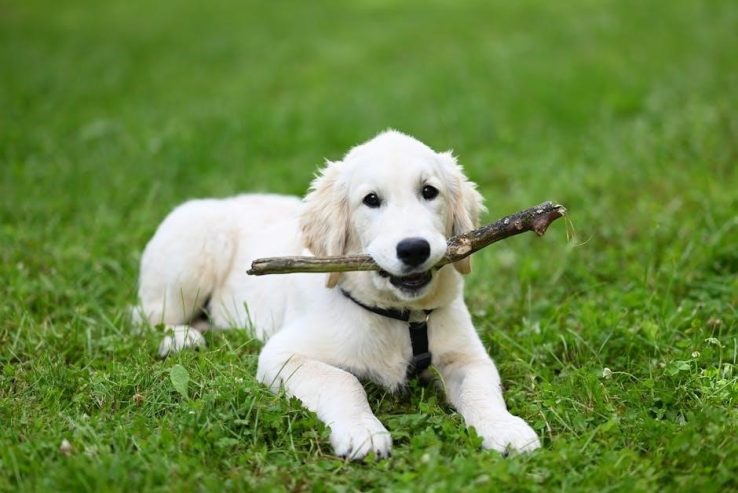Puppy potty training is essential for busy pet owners to establish a routine, preventing accidents and strengthening the bond with their pets. Consistency and positive reinforcement are key to successful training, even with a hectic schedule.
1.1 Understanding the Importance of Potty Training
Potty training is crucial for maintaining your puppy’s health, your home’s cleanliness, and strengthening your bond. It prevents accidents, reduces odor issues, and helps establish a routine. Consistency and positive reinforcement are key to successful training, ensuring your puppy learns to go outside or use designated areas. This foundation also prevents long-term behavioral issues and creates a happier, healthier environment for both you and your pet.
1.2 Challenges Faced by Busy Pet Owners
Busy pet owners often struggle with time constraints, inconsistent schedules, and the challenge of supervising their puppies. These factors can hinder potty training progress, leading to accidents and frustration. Finding creative solutions, such as scheduling frequent breaks and using training aids, is essential to overcome these obstacles and ensure successful potty training despite a hectic lifestyle.
1.3 Setting Realistic Expectations for Potty Training
Setting realistic expectations is crucial for successful potty training. Puppies, especially young ones, have limited bladder control and may require frequent breaks. Accidents will happen, so patience is key. Progress may be gradual, but consistency and positive reinforcement will lead to long-term success. Busy owners should aim for small, achievable milestones to stay motivated and celebrate progress along the way.
Understanding Puppy Behavior and Biology
Understanding puppy behavior and biology is key to effective potty training. Puppies have natural instincts to eliminate in specific areas and learn through repetition and positive reinforcement daily.
2.1 How a Puppy’s Age and Breed Impact Potty Training
A puppy’s age and breed significantly influence potty training. Younger puppies have smaller bladders and higher energy, requiring frequent breaks. Breeds like Labradors and French Bulldogs may learn faster or face unique challenges. Understanding these factors helps tailor training to their needs and abilities, ensuring a smoother process for busy pet owners to manage effectively always.
2.2 Recognizing Signs Your Puppy Needs to Go
Puppies often exhibit specific behaviors when they need to go, such as sniffing, circling, or squatting. They may also pace or whine. Recognizing these signs early allows busy pet owners to act quickly, reducing accidents. Consistent observation helps establish a routine and prevents mishaps, ensuring effective potty training even with a tight schedule always.
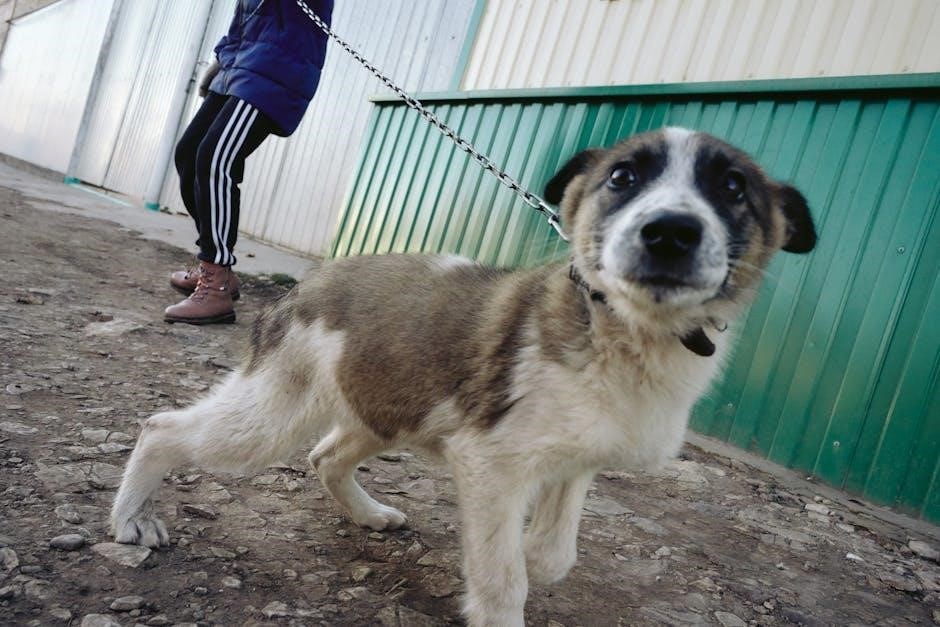
Essential Supplies for Potty Training
Must-have items include puppy pads, grass mats, a scoop, and odor-neutralizing sprays. These supplies help contain messes and eliminate smells, making training manageable for busy schedules.
3.1 Must-Have Items for Successful Potty Training
Essential supplies include high-quality puppy pads for indoor use, absorbent grass mats, and a portable potty area for outdoor training; Odor-neutralizing sprays and a scoop are crucial for cleaning accidents. Treats and toys serve as rewards, while a training schedule helps maintain consistency, ensuring effective potty training even for busy pet owners.
3.2 The Role of Potty Pads and Outdoor Training
Potty pads provide a convenient indoor solution for busy schedules, while outdoor training helps puppies associate specific areas for elimination. Using both methods ensures flexibility and accelerates learning. Transitioning from pads to outdoor training requires consistency and positive reinforcement, making the process smoother for both puppies and their owners.
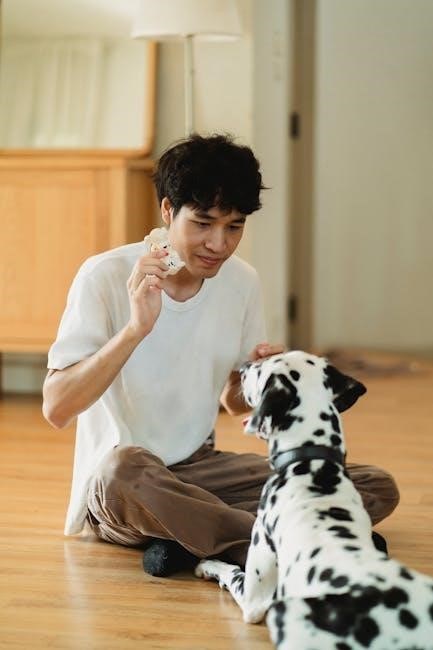
Creating a Consistent Routine
A consistent routine is crucial for successful potty training. Schedule regular feeding times, potty breaks, and playtime to create predictability and reduce accidents, especially for busy owners.
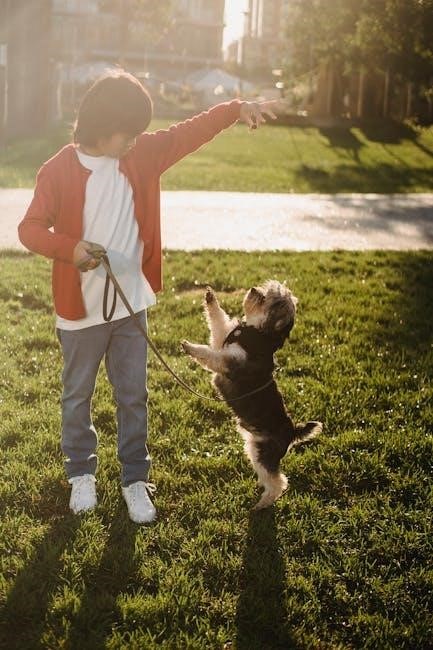
4.1 Developing a Schedule for Feeding and Potty Breaks
Develop a structured schedule by aligning feeding times with potty breaks. After meals, puppies usually need to go, so immediately take them to the designated area. Consistency helps them learn quickly. For busy owners, setting reminders ensures timely breaks, preventing accidents and reinforcing good habits from the start.
4.2 How to Incorporate Potty Training Into a Busy Schedule
Busy schedules can still accommodate potty training by using short, frequent breaks. Set reminders for regular potty times, such as after meals or play. Utilize puppy pads or a small outdoor area for quick access. Involving family members or hiring a dog walker can also help maintain consistency when you’re unavailable.
Cleaning Up Accidents Effectively
Cleaning up accidents involves promptly removing visible traces and neutralizing lingering smells. Use specialized cleaners with enzymes to eliminate odors, discouraging repeat behavior in the same area.
5.1 The Importance of Properly Cleaning Accidents
Properly cleaning accidents is crucial to prevent lingering odors that may attract your puppy to the same spot again. Use enzyme-based cleaners to break down organic matter, effectively removing smells. This helps your puppy associate the area with its intended purpose, reducing repeat accidents. Consistent cleanup reinforces training and maintains a hygienic environment for both your pet and family.
5.2 Using the Right Cleaning Products to Remove Odors
Enzyme-based cleaners are essential for removing puppy accident odors, as they break down organic matter effectively. Avoid ammonia-based products, as they can attract your puppy to the same spot. Neutralizing odors thoroughly deters repeat accidents and helps your puppy learn to go potty in the right places. Always choose pet-safe cleaners for a hygienic and odor-free home.
Managing Accidents and Setbacks
Accidents are inevitable during potty training. Stay calm and patient, as scolding can hinder progress. Use each setback as a learning opportunity to refine your strategy and routine.
6.1 Why Accidents Happen and How to Prevent Them
Accidents occur due to inconsistent schedules, lack of supervision, or a puppy’s small bladder capacity. To prevent them, stick to a strict routine, watch for signs, and reward good behavior. Frequent breaks and positive reinforcement help minimize setbacks, ensuring progress in potty training even for busy pet owners.
6.2 Staying Patient and Persistent During Training
Staying patient and persistent is crucial for successful potty training. Celebrate small victories and remain calm during setbacks. Consistency reinforces good habits, even with a busy schedule. Remember, accidents are part of the learning process. Positive reinforcement and a routine will help your puppy grow into a well-trained companion.
Reinforcing Good Potty Habits
Reinforce good potty habits with positive reinforcement, consistency, and rewards. Celebrate successes, and gently correct accidents. Creating a predictable routine helps solidify learning, ensuring long-term success.
7.1 Using Positive Reinforcement Techniques
Positive reinforcement is a powerful tool in puppy potty training. Reward desired behavior with treats, praise, or play to encourage repetition. Consistency and immediate rewards help puppies associate correct actions with positive outcomes, fostering faster learning and a stronger bond with their owners. This method builds confidence and reduces the chance of accidents effectively.
7.2 The Role of Treats and Praise in Training
Treats and praise are essential in puppy potty training, acting as immediate rewards that reinforce good behavior. Consistency in using these positive reinforcements helps puppies quickly understand and repeat the desired actions. Busy owners can effectively utilize these methods to maintain training progress even with limited time and strengthen the bond between pet and owner.
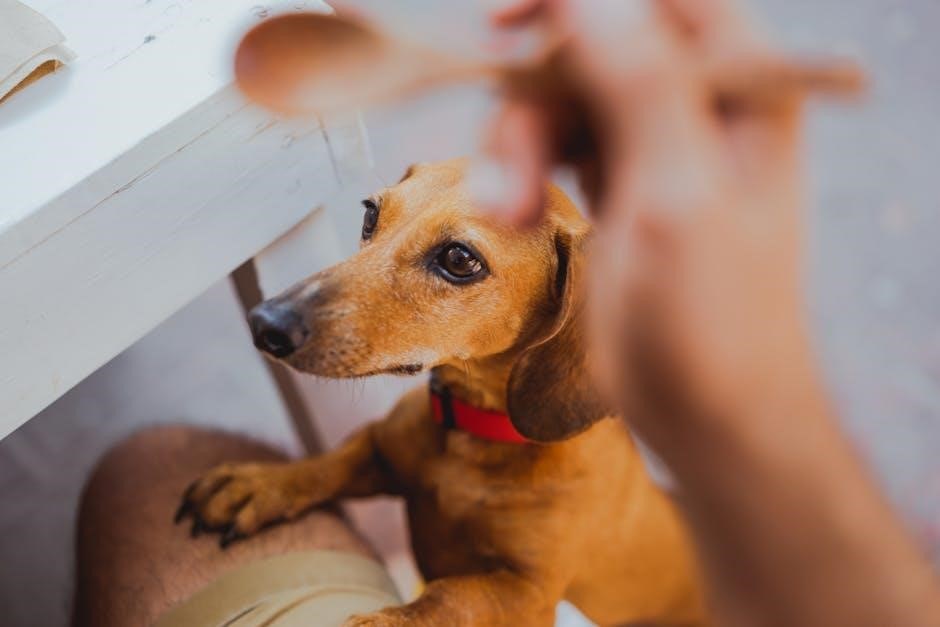
Outdoor Training Tips
Outdoor training offers puppies a natural environment to learn. Choose a specific area, use consistent commands, and reward immediately to reinforce good habits and speed up training.
8.1 Choosing the Right Outdoor Potty Area
Selecting the right outdoor potty area is crucial for effective training. Opt for a quiet, easily accessible spot close to your home to encourage quick trips. Ensure the area is free from distractions and hazards, making it safe for your puppy. Consistency in location helps your puppy associate the area with potty time, reducing accidents and speeding up the learning process.
8.2 Training Your Puppy to Signal When They Need to Go
Teach your puppy to signal when they need to go by associating a specific command, like “go potty,” with the action. Encourage them to sniff and circle before relieving themselves. Reward with treats and praise when they successfully signal. Consistency and positive reinforcement help your puppy learn this valuable communication skill, making outdoor training more efficient and reducing accidents.
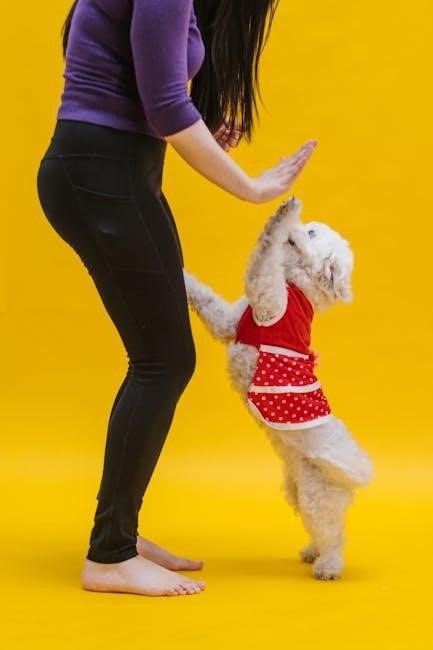
Using Potty Training Aids
Puppy pads and grass mats are essential tools for potty training, offering convenience and consistency. They help puppies learn to go in designated areas, reducing accidents.
9.1 The Benefits of Puppy Pads and Grass Mats
Puppy pads and grass mats provide convenience for busy owners, allowing puppies to go indoors when outdoor access is limited. They reduce accidents and make cleanup easier, helping puppies learn faster. These aids are especially useful during inclement weather or for small breeds that need frequent breaks, ensuring consistency in training routines.
9.2 How to Transition from Pads to Outdoor Training
Transitioning from pads to outdoor training involves gradually moving potty areas outside. Start by placing pads near the door, then outside. Consistent routines and positive reinforcement help puppies adapt. Over time, phase out pads, encouraging puppies to go directly outdoors, ensuring a smooth and successful transition to outdoor potty training.
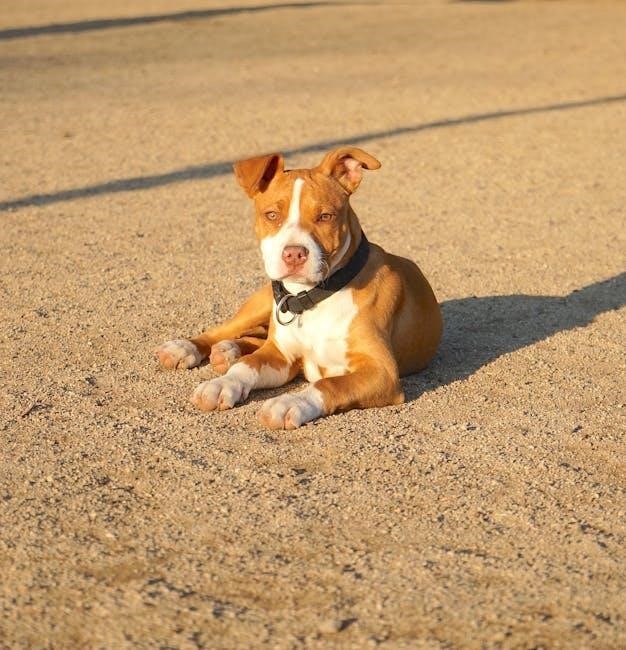
Maintaining Consistency While Away from Home
Maintaining consistency while away requires clear communication with caregivers, using familiar aids like potty pads, and ensuring your puppy’s routine and environment remain consistent for effective training.
10.1 Tips for Training When You’re Not at Home
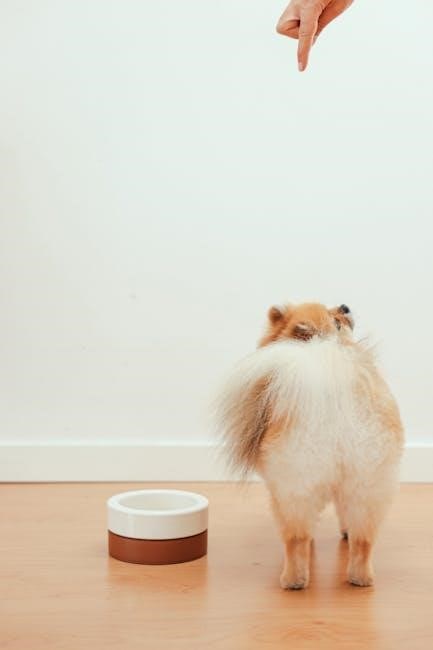
When you’re away, ask a trusted friend, family member, or pet sitter to follow your puppy’s routine. Provide clear instructions and ensure they use familiar aids like potty pads or designated outdoor areas. Consistency is key, so share your schedule and reward system. Consider using a puppy camera for real-time monitoring and adjustments. This helps maintain progress even in your absence.
10.2 Involving Others in the Training Process
Involving family, roommates, or pet sitters ensures your puppy’s training remains consistent. Delegate tasks like feeding times, potty breaks, and clean-ups. Share your routine and reward system to maintain uniformity. Communication is crucial, so create a shared schedule or checklist to track progress. This teamwork approach helps reinforce good habits and reduces the risk of setbacks while you’re away.
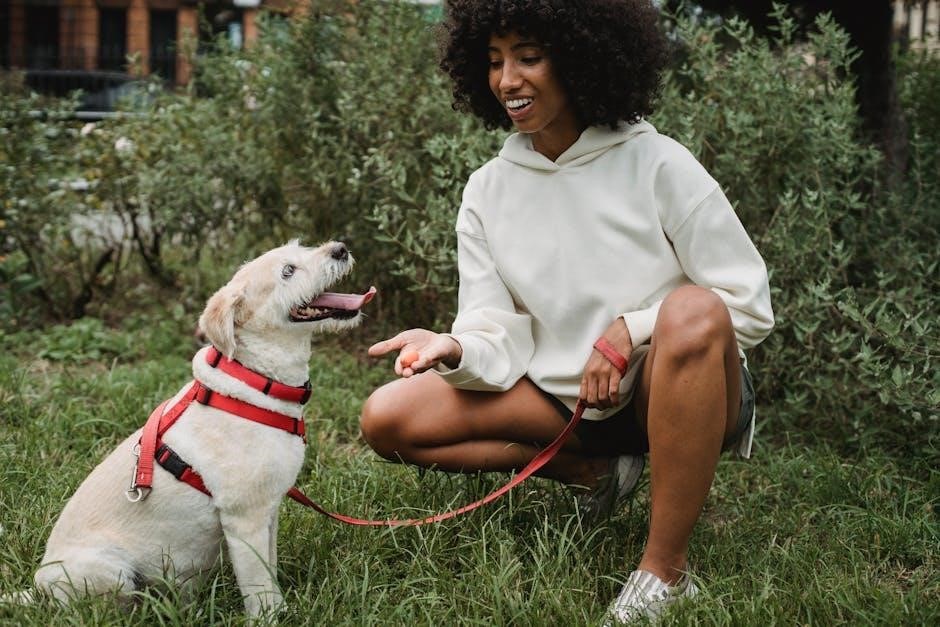
Final Thoughts and Next Steps
Mastering puppy potty training requires patience and consistency. Celebrate small victories and stay committed to reinforcing good habits. Gradually transition to advanced training for a well-behaved pup.
11.1 Celebrating Progress and Milestones
Acknowledge every achievement, no matter how small, to motivate both you and your puppy. Use positive reinforcement like treats and praise to mark progress. Celebrating milestones strengthens the bond and encourages continued success in potty training. Consistency and patience are key to fostering a well-behaved and confident pup.
11.2 Continuing to Reinforce Good Habits
Consistency is key to maintaining progress. Positive reinforcement, like treats and praise, helps solidify good habits. As your puppy grows, adjust routines to meet their changing needs. Involve family members to ensure everyone follows the same training cues. Stay patient and celebrate small victories to keep motivation high and encourage long-term success in potty training. This dedication ensures your puppy thrives and becomes a well-behaved companion.
Mastering puppy potty training as a busy pet owner requires consistency, patience, and positive reinforcement. With dedication, you’ll establish lifelong habits, ensuring a happy, healthy relationship with your puppy.
12.1 The Long-Term Benefits of Successful Potty Training
Successful potty training leads to a cleaner home, reduced stress, and a stronger bond with your puppy. It fosters healthier habits, prevents unwanted behavior, and ensures your puppy grows into a well-adjusted adult. Consistency and positive reinforcement create a foundation for lifelong good habits, making your role as a pet owner more enjoyable and rewarding.
12.2 Encouragement for Busy Pet Owners
Busy schedules can make puppy potty training challenging, but with consistency and patience, it’s achievable. Celebrate small victories, and remember, every step forward is progress. Don’t hesitate to use training aids or seek support when needed. You’re building a lifelong bond with your puppy, and it’s worth every effort. Stay committed, and you’ll see success.
